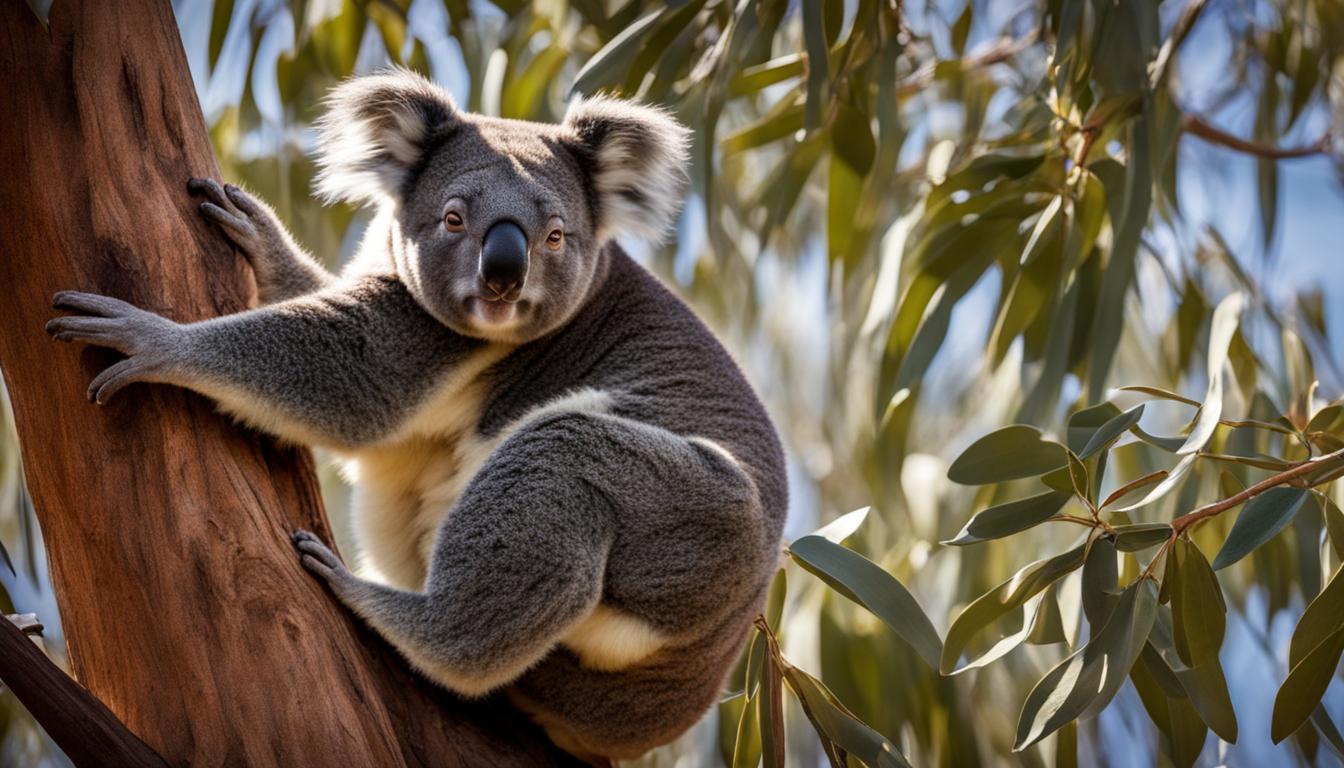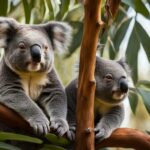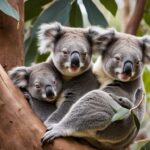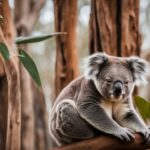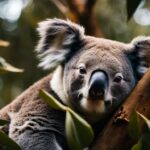When it comes to the adorable koalas, you might wonder if they have any natural enemies in their wild habitat. Well, you’ll be glad to know that koalas are not commonly preyed upon by other animals. They have managed to navigate their way through the Australian ecosystem without being a top choice for predators. However, that doesn’t mean they are completely out of harm’s way.
Koalas face threats that are largely attributed to human activities, such as habitat loss and climate change. These factors pose significant risks to the survival of these iconic marsupials. While they may not have many natural predators, the challenges they face are still a matter of concern for their overall well-being and conservation efforts.
In the following sections, we will delve deeper into the behavior and habitat of koalas, the various threats they encounter, the risks of predation they may face, and the ongoing efforts to conserve and protect these lovable creatures and their delicate ecosystem.
Koala Behavior and Habitat
Koalas, with their characteristic fluffy ears and adorable appearance, have fascinating behavior and unique habitat requirements. Understanding their behavior and habitat is essential for their conservation and protection.
Koalas have a slow metabolism and spend most of their time sleeping, up to 20 hours a day, due to their diet of tough-to-digest eucalyptus leaves. They are primarily active at night, when they climb high up in gum trees to feed on their favorite food. Koalas are highly selective eaters and depend on specific eucalyptus species for their survival.
Koalas are found in Eastern Australia, where they require a large habitat with a sufficient number of trees to meet their dietary needs. They have a relatively small home range, typically less than one square kilometer, and are known to be territorial. Their habitats need to provide the right balance of eucalyptus species, water sources, and suitable shelter, such as tree hollows.
In summary, koalas’ behavior revolves around their slow metabolism, sleep patterns, and selective eating habits, while their habitat must meet specific requirements for food, water, and shelter. Protecting and conserving koalas and their habitat is crucial to ensure the long-term survival of this iconic species.
Koala Threats: The Challenges Facing Australia’s Iconic Marsupials
As adorable and beloved as koalas may be, their survival in the wild is under serious threat. While these tree-dwelling marsupials have few natural predators, it is human activities that pose the greatest danger to their existence. The primary threats to koalas include habitat loss, urban development, and the devastating impacts of climate change.
One of the most significant threats to koalas is the destruction of their natural habitat. Clearing land for agriculture, housing, and other purposes has resulted in the loss of critical eucalyptus forests that koalas rely on for their survival. As urban areas continue to expand, the remaining habitats are fragmented, making it even more challenging for koalas to find suitable food sources and mates.
Climate change further exacerbates the already dire situation for koalas. Rising temperatures and prolonged droughts impact the health and availability of eucalyptus trees, leading to a decline in the quality and quantity of their primary food source. Additionally, extreme weather events, such as bushfires, can devastate koala populations and destroy their habitats.
The Impact of Human-Induced Threats
“The destruction of koala habitat by human activities is driving these iconic animals towards extinction. Urgent action is needed to address the root causes of their decline and ensure their long-term survival.” – Conservationist John Smith
While koalas face few natural predators in the wild, the combination of habitat loss and human-induced threats has caused a significant decline in their population. Other human-related risks include car accidents, disease transmission, and the encroachment of urban areas into koala habitats.
| Koala Threats | Impact |
|---|---|
| Habitat Loss | Fragmentation of habitats, limiting food sources and breeding opportunities. |
| Urban Development | Encroachment into koala habitats, leading to habitat destruction and displacement. |
| Climate Change | Altered habitat conditions, including food scarcity and increased vulnerability to extreme weather events. |
| Car Accidents | Collision with vehicles as koalas cross roads when moving between trees. |
| Disease Transmission | Increased susceptibility to diseases due to stress and weakened immune systems. |
It is crucial to address these threats and take action to protect and conserve koalas and their habitats. Efforts such as habitat restoration, predator management, and public awareness campaigns are essential in ensuring the survival of these iconic animals for future generations to enjoy.
Koalas and Predation Risks
Koalas, known for their tree-dwelling lifestyle, have few natural predators in the wild. However, when they come down from trees or are on the ground, they become vulnerable to predation. Dingoes, birds of prey, snakes, and wild dogs are among the predators that pose risks to koalas, especially the juveniles.
Dingoes are a significant threat to koalas when they venture onto the ground. These wild dogs, found in various parts of Australia, are opportunistic hunters and can prey on koalas in certain situations. While dingoes primarily feed on small mammals and kangaroos, they have been known to attack and kill koalas when the opportunity arises.
Birds of prey such as owls and eagles also pose risks to koalas, particularly the young ones. These birds have sharp claws and excellent hunting skills, making them efficient predators. When young koalas venture away from their mothers and explore their surroundings, they can become targets for birds of prey. The aerial hunting abilities of these birds give them an advantage in capturing koalas from the treetops.
Snakes are another predator that koalas need to be cautious of. While snakes mainly feed on small mammals and reptiles, they can occasionally prey on koalas. Although koalas spend most of their time in trees, they may come into contact with snakes when moving between trees or when they accidentally encounter a snake on the ground. Snakes can pose a threat to both adult koalas and their young.
Wild dogs such as foxes and feral cats also contribute to the predation risks faced by koalas. These introduced predators can prey on vulnerable koalas, especially when their habitats are disrupted or fragmented. Urbanization and habitat loss have brought these predators into closer proximity with koalas, increasing the chances of predation.
| Predator | Risk Level |
|---|---|
| Dingoes | High |
| Birds of Prey | Moderate to High |
| Snakes | Low to Moderate |
| Wild Dogs (Foxes, Feral Cats) | Low to Moderate |
While koalas have evolved to adapt to their arboreal lifestyle and minimize predation risks, human-induced factors such as habitat loss and fragmentation have brought them into closer contact with potential predators. Conservation efforts that focus on preserving and restoring their habitats, as well as managing predator populations, are crucial for ensuring the long-term survival of koalas in the wild.
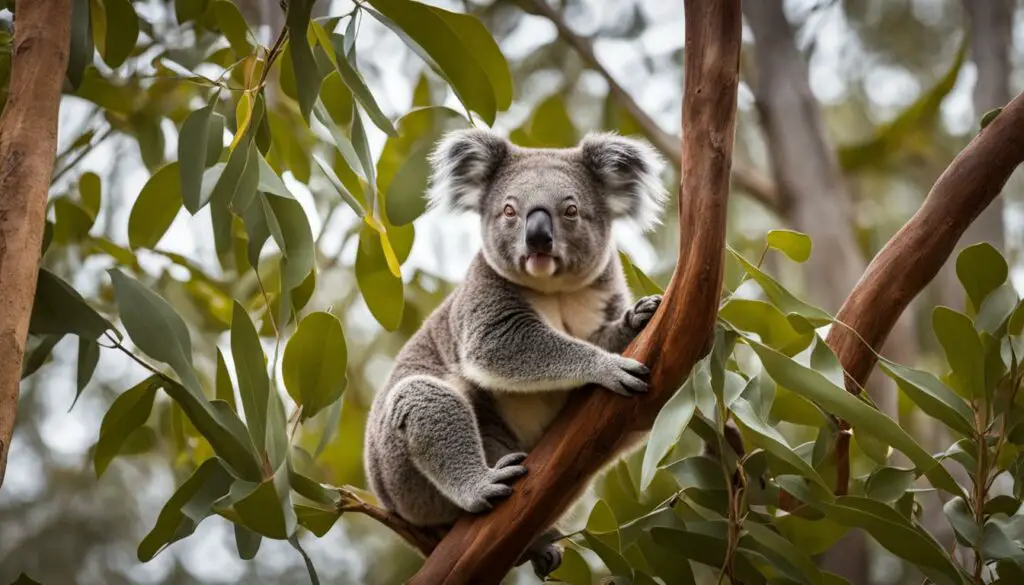
Koala Conservation Efforts
Conservation organizations like Bush Heritage are dedicated to protecting koalas and their habitat. Through a range of initiatives, these organizations aim to ensure the long-term survival of this iconic species.
Habitat Protection
One of the key conservation efforts for koalas is the protection of their natural habitat. This involves preserving existing forests and creating new areas of suitable habitat. By maintaining a sufficient number of trees, koalas have access to food and shelter, which is essential for their survival. Government regulations play a crucial role in designating protected areas and enforcing strict guidelines to prevent habitat destruction.
Predator Management
Efforts are also underway to manage potential predators of koalas. While koalas have few natural enemies in the wild, predators like dingoes, birds of prey, snakes, and wild dogs can pose risks, especially to young koalas. Predator management includes strategies such as trapping and relocation, as well as targeting the sources of predation to prevent attacks. By reducing the threats from predators, the survival rate of koalas can be improved.
Public Awareness and Education
Raising public awareness about koalas and their conservation needs is crucial for their long-term survival. Conservation organizations engage in educational programs, community outreach, and media campaigns to inform the public about the importance of koalas and the threats they face. By increasing public knowledge and understanding, individuals can make informed choices and actively support conservation efforts.
Government Regulations
Government regulations play a vital role in supporting koala conservation. These regulations help control activities that can harm koala populations, such as deforestation, urban development, and land clearing. By implementing and enforcing regulations, governments can ensure that koala habitats are protected and that actions detrimental to their survival are minimized.
| Conservation Effort | Description |
|---|---|
| Habitat Protection | Preserving and creating suitable habitat for koalas |
| Predator Management | Managing potential predators to reduce risks to koalas |
| Public Awareness and Education | Informing the public about the importance of koalas |
| Government Regulations | Enforcing regulations to protect koala habitats |
Conclusion
The koala population decline is a pressing concern that calls for immediate action to ensure the survival of these beloved creatures. The main factors contributing to this decline are habitat loss and human activities. While koalas have few natural predators in the wild, they face significant risks from human-induced threats.
Conservation efforts play a crucial role in protecting koalas and their habitat. Actions such as habitat protection, predator management, and public awareness are essential in reversing the decline of koala populations. Organizations like Bush Heritage are dedicated to these conservation efforts, but public support and donations are vital to making a lasting impact.
With the help of government regulations and protected areas, we can create a safer environment for koalas. By raising public awareness about the importance of koalas and their role in the ecosystem, we can encourage more people to take part in conservation efforts. Together, we can make a difference in preserving the future of koalas and their habitat.
Do Natural Predators of Koalas Affect their Conservation Efforts?
The presence of natural predators like dingoes and owls can pose challenges to successful koala conservation cases. These predators can impact koala populations, making it difficult to maintain healthy numbers in the wild. Conservation efforts must take into account the threat posed by these natural predators to ensure long-term success.
FAQ
Are there any natural predators of koalas in the wild?
While koalas have few natural predators, they can still face risks from dingoes, birds of prey like owls and eagles, snakes, and wild dogs such as foxes and feral cats.
What are some behaviors and characteristics of koalas?
Koalas have a slow metabolism and sleep for up to 20 hours a day. They are mostly active at night and live high in gum trees. They are highly selective eaters and depend on specific eucalyptus species.
What are the main threats to koalas?
The main threats to koalas include habitat loss due to clearing of land for agriculture and urban development, as well as climate change, bushfires, car accidents, and disease.
What are some predation risks that koalas face?
Koalas are vulnerable to predation when they come down from trees or are on the ground. Dingoes, birds of prey, snakes, and wild dogs such as foxes and feral cats pose risks to koalas, especially juveniles.
What is being done to conserve koalas?
Conservation organizations are working to protect koalas and their habitat through efforts such as habitat restoration, predator management, monitoring programs, and raising public awareness. Government regulations and protected areas also play a crucial role in conserving koalas.
What is the impact of habitat loss on koala populations?
The decline of koala populations is primarily caused by habitat loss and human activities. While koalas have few natural predators in the wild, they face significant risks from human-induced threats.

